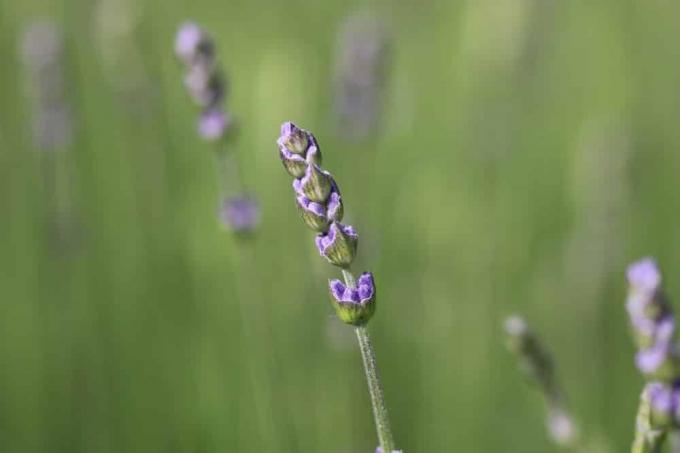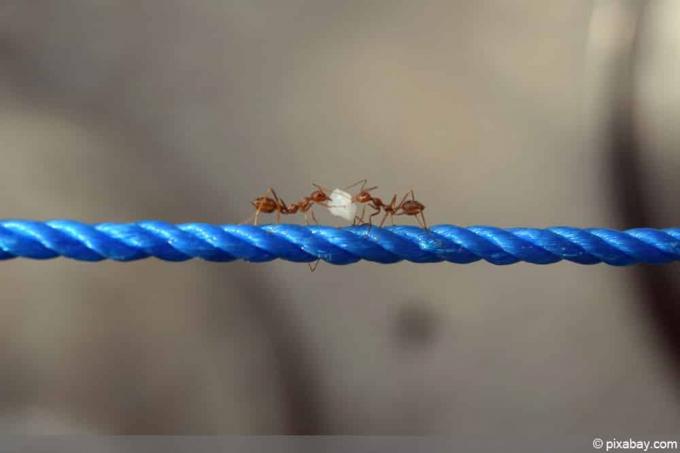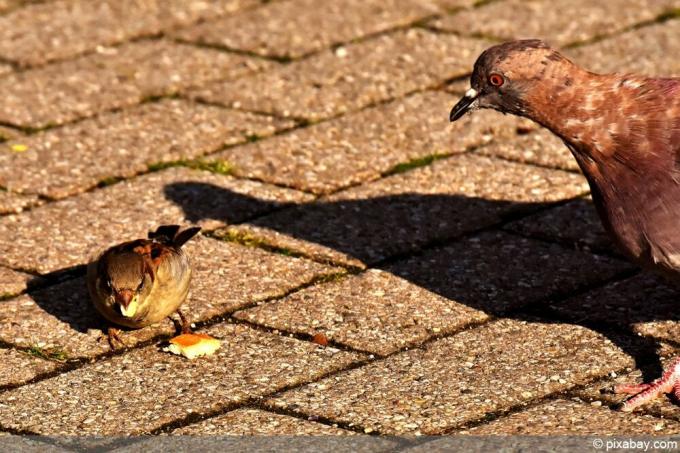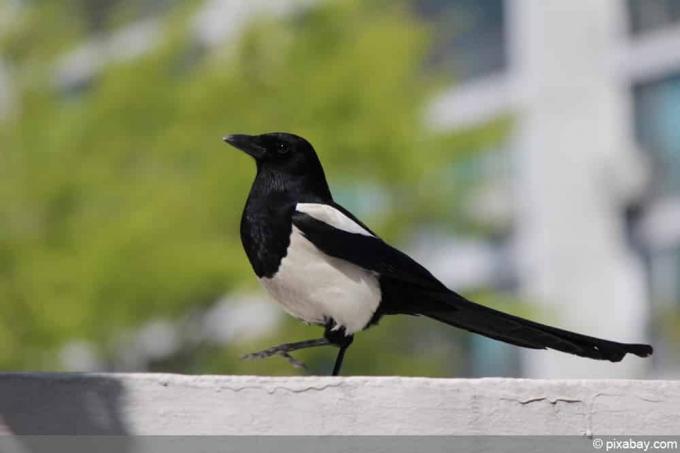

Table of contents
- The type of lavender is crucial
- Fight vermin in the garden
- Fight vermin in the house
- Make lavender essence
- Garden with foresight and benefit twice over
Unfortunately, a pest rarely comes alone. To make matters worse, by feeding on the host plant and excreting honeydew, aphids attract ants. However, the lavendula does not have this problem. Its aroma has a repellent effect on animals. It is therefore possible to protect other plants from infestation with the purple plant. In this guide, the gardener will find helpful tricks, from bed borders to lavender oil, to fight pests naturally.
The type of lavender is crucial
The lavendula plant actually drives away pests such as ants, aphids or fleas with its scent. However, the effect depends on the intensity of the smell. In this regard, the stronger the scent, the more effective Lavendula is. Accordingly, the new breeds usually have the typical, very distinctive lavender scent in order to keep parasites away. Three species of the plant occur naturally, which are divided into further sections. Since most of them are not hardy and for this reason cannot be cultivated in this country, only a few species are of interest to the German gardener. These include, in ascending order of fragrance intensity:
The woolly lavender(Lavandula lanata), Section I
- has silvery, hairy leaves
- not hardy
- subtle fragrance
The real lavender(Lavandula augustifolia), Section I
- very common in home gardens
- rather short stature
- flowers pink, white, dark violet or bluish
- is used for oil extraction (is considered the most expensive lavender oil because it has the purest scent)
- smells delicate and mild
The butterfly lavender(Lavandula pedunculata), the crested lavender(Lavandula stoechas L.) and the Green lavender(Lavandula viridis), Section III
- only hardy down to -5°C, therefore only intended for the tub
- bloom purple
- smell sweet and slightly of camphor
The French Lavender / Tooth Lavender(Lavandula dentata), Section II
- has serrated leaves
- solid blue colored flowers
- especially suitable for the bucket
- rather rare variety
- very aromatic, resinous scent
The spike lavender(Lavandula latifolia/Lavandula spica) Section I
- has long flower stalks
- forms numerous branches
- is used for oil production (spitting oil, very productive)
- Can only be cultivated as a container plant as it is sensitive to frost
- smells very strongly of camphor
A notice:
When purchasing a lavender to repel vermin, gardeners are best guided by the color of the flowers. Purple flowering strains tend to have a stronger, more impactful aroma. In addition, the location is also crucial. The plants smell more in the sun than in the semi-shade.
Fight vermin in the garden
Cultivating lavendula in the garden is therefore probably the most natural way to drive away lice, fleas and ant infestations. A mixed culture in which the plants benefit from each other is particularly recommended. Thanks to its attractive flowers, Lavendula is a decorative border for beds and is also a good groundcover in cottage gardens. However, the gardener should note that not every plant feels comfortable around the purple herb. Lavendula requires dry soil and plenty of sun. The popular combination with roses is therefore controversial. It is also important that Lavendula is in full sun so that it can fully develop its essential oils. According to experience reports, aphids have migrated from a rose to the herb because its fragrance was too weak. In order to effectively prevent pests, the gardener should therefore choose the most intensive varieties possible, such as spike lavender.
Tip:
With unsuitable plant neighbors or simply to bring some variety to the blooming violet, can the gardener also uses strongly scented herbs such as savory, sage, thyme, oregano or mint To fall back on.
Fight vermin in the house
Since the honeydew-producing aphids attract ants, the priority is to combat the plant pests. As a result, the ant problem usually resolves itself. But what if, for example, the smell of food attracts the insects? Ant trails in the house are not only annoying, but also unhygienic. In the bed or on the terrace, the intensively scented spike lavender is the first choice. However, since it hardly reminds of the lovely lavender scent, but smells very strong, it is rather out of place in the apartment.

The use of lavender oil is therefore recommended for closed rooms. High-quality essences are available in almost all drugstores or health food stores. The gardener puts a few drops in water, fills the liquid in a spray bottle and sprays furniture or fabrics with it. He should apply the scent especially on the windowsill so that the insects don't get into the apartment in the first place. If you have a lavender plant in your garden, you can also make the fragrance yourself:
Make lavender essence
- Harvest dry lavender flowers (a handful is enough)
- douse with boiling water
- leave for a few hours
- strain and catch the brew
Tip:
The gardener can also add the liquid to the irrigation water and use it to water the plants both indoors and outdoors.
Garden with foresight and benefit twice over
The gardener does not necessarily need to process the stalks of lavender into oil. It is also possible to use the dry stalks to mulch rose beds. This not only prevents aphid infestation, under favorable conditions Lavendula even sows itself.
 garden editorial
garden editorial I write about everything that interests me in my garden.
Learn more about animal defense

Bird repellent: with these means you drive birds away from the balcony
Pigeons, sparrows and many other bird species often choose a balcony as a resting or even nesting place in the city. However, to ensure that your own balcony is spared bird droppings in particular, there are various measures that can be used effectively here without harming the animals.

Scare away foxes from the garden and keep them away
Whether in the city or in the country - more and more hobby gardeners meet foxes in their own green kingdom and ask themselves how they can scare them away. We have summarized which measures are best suited for this in this article!

Prevent birds under roof tiles and roof overhang
If birds settle under the roof tiles and the roof overhang, this can lead to damage to the building fabric. The droppings cause unsightly dirt, and breeding songbirds make a lot of noise. Various countermeasures have proven effective in preventing unwanted colonization.

Remove sparrow nest under the roof
Where people live, sparrows are not far either. With a few exceptions, this applies all over the world. Sparrows are cultural followers, they have adapted to the way of life of humans. What to do if sparrows breed under the house roof?

Recognizing magpie droppings | Magpie droppings with picture
Bird droppings on the terrace or on the light wall of the house are a nuisance. What culprit is behind this? Was it the magpies? We'll show you how to spot magpie droppings and how to get rid of them.

Recognize badger droppings in the garden: 6 characteristics
Have you ever seen a badger in the wild? The animals with the black stripes on their faces are common in German forests. She is increasingly drawn to the city. Their legacies are annoying. How can badger droppings be identified?
